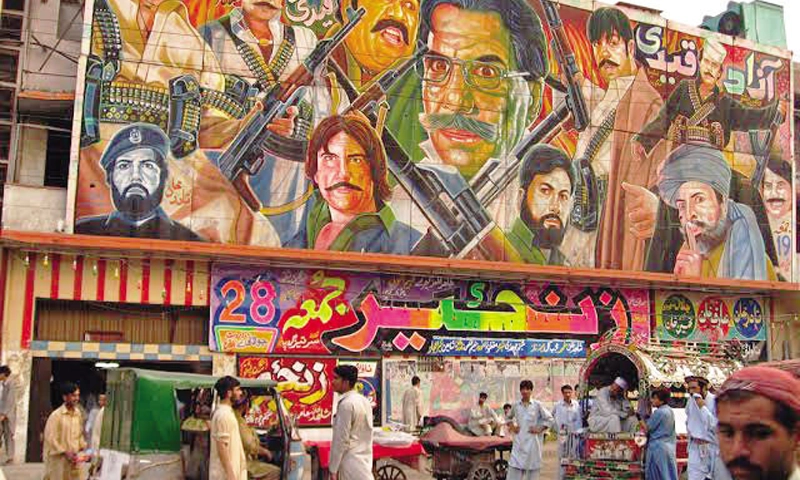- Web Desk
- Today
Peshawar had 16 cinemas. Soon there would be only two
-

- Web Desk
- Jul 13, 2025

PESHAWAR: Peshawar, once known as a city of flowers, is now covered by dust and has very little greenery thanks to the “concrete revolution”. It also had a large number of cinemas, 16 in total, showing that the provincial capital was a vibrant art and culture centre as well. However, there soon would be only two remaining.
Usman Sultan in a report for HUM News says Arshad Cinema, the largest in Peshawar, has also been selected for demolition, only to be replaced by a shopping plaza.
It is the third cinema to fall this year. Earlier, the Picture House and the Naz Cinema also became a victim of commercialisation.
Arshad Cinema was located on the Shahi Bagh Road.
Meanwhile, the Shahi Bagh itself is a reminder why Peshawar was named as the city of flowers – a Mughal-era garden that covers an area of approximately 100 acres.
Yousaf Chacha is associated with the Arshad Cinema for the last 40 years. He is currently working on saving the movies in digital format. It is his last responsibility for the cinema because its future has been decided.
But why it was given the name of Arshad Cinema?
In 1970s, renowned producer Sardar Khan Lala produced Orbal, which considered a classic in the Pashto film industry. The movie was based on the tradition of Swara – a tradition where families, clans or tribes barter their daughters to settle feuds.
Later in 1984, Arshad Khan built the cinema. So the name Arshad Cinema.
BLEAK FUTURE
The film industry employees thousands and even hundreds of thousands of people directly or indirectly. It depends upon the size of a given industry. So if we are talking about Hollywood or Bollywood, then the numbers are pass.
In the case of Hollywood, the total is estimated around 0.722 million in California only. Just add the numbers from Georgia and other US states.
The closure of these cinemas in Peshawar means hundreds of people directly lost their jobs over the past years. More are expected to be jobless soon.
“I have been working in this cinema for the last 15 years. I don’t have any other skills. I don’t know what I would do after the cinema is erased,” said one of the workers.
WHY THIS TREND
Demolishing the cinemas started in Karachi late 1990s, which gained alarming momentum in the later years. It was repeated simultaneously in Lahore – the Lollywood, Pakistan’s alternate for Hollywood and Bollywood.
It forced thousands of people associated with the industry to seek other livelihood sources.
Reason? We stopped producing films. Reasons were multiple – from lack of finances and technology to rise of extremism which discouraged arts and culture as well as suppression of ideas.
However, the arrival of VCRs in late 1970s people had much better options in the shape of Hollywood and Bollywood movies. Add DVDs and the streaming services, the result is cinemas are no more a viable business option, at least in country like Pakistan where local production is more or less absent.’
One shouldn’t be surprised because of this decades-long process. Consumerism means consumers always look for better and affordable products.
But it doesn’t mean that cinemas are dead around the world. India, Europe and the United States adapted to the changes. They have products. Instead of big cinema halls, they opted for mini theatres or micro cinemas everywhere. In shopping malls, in business centres, in residential skyscrapers.
Meanwhile, the cinemas in Peshawar relied heavily on Pashto movies. With the golden era of Pashto movies gone, the owners could not bear the losses.
OPTIONS FOR VIEWERS
As far as the ordinary people are concerned, they don’t have any option when it comes to entertainment and leisure. In other words, the low-income groups are again the losers.
However, the middle class, if there is any given the unending purchasing power crisis, and the upper-middle class can have movies on streaming services like Netflix.
With the extremism and terrorism haunting the people in Khyber Pakhtunkhwa for over decades, the arts and culture is in the grasp of very few people. Targeting singers and other artists has become a routine, forcing others to migrate to other parts of Pakistan.
Meanwhile, it would be in interesting study to find how many people allow streaming services in their homes in Khyber Pakhtunkhwa given the conservative nature of the society.
LESSON
Peshawar, which gave the world the likes of Raj Kapoor and Dilip Kumar, would soon be without a cinema.




